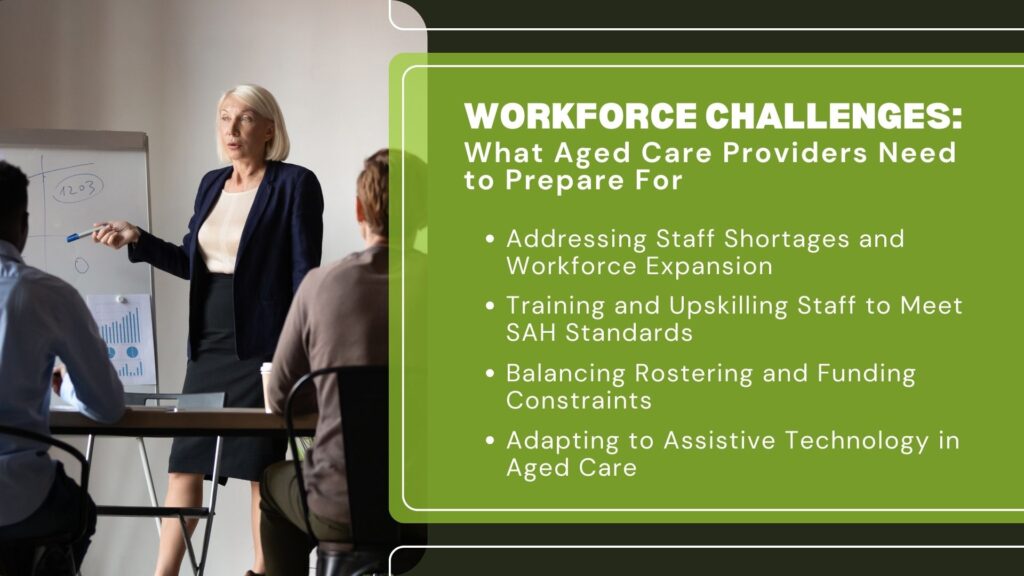The Support at Home (SAH) program is set to launch in July 2025, consolidating existing in-home care programs into one streamlined system. This initiative aims to simplify the delivery of aged care services, making them more efficient and accessible for older Australians. The SAH program’s focus is on improving care quality by offering a broader range of services, including clinical care, daily support, home modifications, and end-of-life care.
As part of the aged care reforms summary, the SAH program introduces a more structured approach to service delivery, which will significantly impact staffing needs. Aged care providers will face new challenges in workforce planning, hiring, and ensuring the quality of service delivery under the program’s expanded scope. These changes will require a well-prepared workforce with diverse skill sets to meet the evolving needs of the aged care sector.
How the Support at Home Program Changes Staffing Needs
The shift from multiple aged care programs (HCP, CHSP, STRC) to the single Support at Home (SAH) system requires a more structured staffing approach. The consolidation simplifies service delivery but increases the complexity of staffing needs. Providers must adapt to managing a wider variety of services under one program, which demands a more organised and skilled workforce.
The SAH program’s broad service scope—covering clinical care, daily support, home modifications, and end-of-life care—requires diverse skill sets. Staff members must possess different specialised skills because aged care providers must recruit workers with multiple areas of expertise.
The Introduction of care management positions stands as a major operational change under SAH because 10% of participants’ budgets must cover care management expenses. This new system strengthens care management through centralisation, therefore, these professionals play a critical part in care coordination and service delivery. The program requires increased employment of nurses, along with personal carers and therapists, and home modification specialists to service a broadened service range. Preparations require attention to define how the changing workforce needs will be addressed while meeting all intended budget levels.
This shift is a direct outcome of the aged care reform news, which highlights the program’s push for greater service integration and more specialised care roles. Providers must start planning now to meet these staffing demands and ensure they have the right skill sets for the expanded service offerings.
Workforce Challenges: What Aged Care Providers Need to Prepare For

The program’s broader service scope and increased demand for skilled staff will require careful planning and preparation. Providers must address current workforce shortages, expand their teams, and ensure their staff are equipped with the necessary skills to meet the program’s requirements.
Addressing Staff Shortages and Workforce Expansion
The aged care sector currently faces substantial worker shortages because numerous positions remain empty. The Support at Home (SAH) program will create more demand for skilled workers because of its wider service offerings. The program’s increased complexity of needs requires providers to hire a larger staff to fulfill the program’s requirements. A workforce expansion is crucial to fulfill staffing requirements while preserving quality care under the revised system.
Training and Upskilling Staff to Meet SAH Standards
The SAH program expands service capabilities, which requires employees to possess diverse abilities. Staff members must maintain continuous training for clinical care delivery together with home modification installation and assistive technology implementation. Staff members need to consistently upgrade their skills to achieve the SAH accreditation requirements.
The staff must learn to operate with newly developed assistive technology and home adaptation methods as well as better clinical treatment techniques. The aged care reform roadmap requires regular upskilling of staff so they maintain the necessary skills for expanded services.
Balancing Rostering and Funding Constraints
The SAH program’s funding structure directly impacts staffing levels and rostering. While the program aims to enhance care, budget constraints will challenge providers to balance adequate staffing with financial limitations. Efficient workforce planning will be crucial, with strategies like flexible scheduling and role optimisation to ensure coverage without exceeding budget limits. Providers must adapt to these constraints to maintain high service standards without overspending.
Adapting to Assistive Technology in Aged Care
The introduction of the Assistive Technology and Home Modifications (AT-HM) scheme under the SAH program will require staff to support clients using new technologies, such as mobility aids and home modifications. Staff will need to learn how to incorporate these technologies into daily care routines. This shift demands that workers develop technical skills to effectively use and maintain these devices.
These changes are a direct response to the aged care reforms summary, highlighting the need for a well-prepared, adaptable workforce to meet the evolving demands of the SAH program.
The Role of Compliance and Registration in Staffing
Under the Support at Home (SAH) program, staffing requirements will be closely tied to compliance. Aged care providers must ensure their teams meet the new regulatory standards to continue delivering government-funded services. Registration for the SAH program is essential for providers to remain eligible for funding, and this process will require careful attention to detail. However, the administrative burden of navigating registration and compliance can divert focus from actual service delivery, creating additional pressure on providers.
Registering for Support at Home
At SAH Consulting, we understand that navigating the complexities of the Aged care reforms timeline and meeting compliance requirements can be overwhelming. From understanding the latest guidelines to ensuring your application meets all necessary requirements, the process can be time-consuming and daunting. That’s why we are here to help. Our team of experienced consultants provides expert guidance throughout the entire Support at Home registration process, ensuring a smooth and efficient journey.
We assist you with:
- Understanding the new regulations: We simplify the requirements and offer clear, concise explanations.
- Preparing a robust application: We help gather the necessary documentation and ensure your application is complete and accurate.
- Creating policy and procedure documentation: We develop comprehensive documents to ensure compliance and operational efficiency.
- Addressing any concerns: We are available to answer questions and resolve any issues that arise during the registration process.
- Minimising delays: We streamline the process to reduce potential delays and ensure timely registration.
With SAH Consulting by your side, you can confidently navigate the complexities of the Support at Home registration process, ensuring compliance while focusing on what matters most—providing high-quality care to your clients.
Conclusion
The Support at Home (SAH) program brings key staffing changes, including a need for a more structured workforce and diverse skill sets. Providers must assess workforce needs, expand teams, and ensure staff are trained in areas like clinical care and assistive technology. Compliance with new regulations is essential for continued government funding.
The aged care reforms summary underscores the need for early preparation. By focusing on workforce planning, training, and compliance, providers can adapt successfully to the SAH program. This is an opportunity to build a stronger, more sustainable aged care workforce in Australia.
For expert guidance and support with the Support at Home registration process, SAH Consulting is here to help. Contact us today to navigate the changes and set your aged care service up for long-term success.
